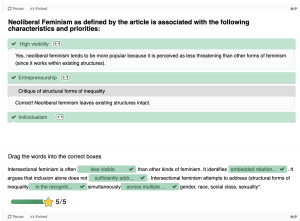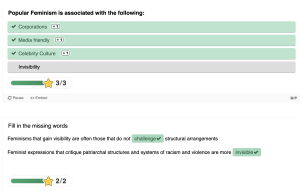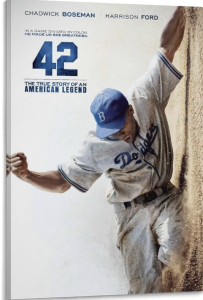3
Section One: The Fundamentals
A) Keywords
Exercise 1:
Briefly (in 100 words or less) define one of the keywords in the padlet (including one that you. may have added yourself).
| Misogynoir, a term used to combine the sexism against women based on the thought that they are inferior or unable to compete with men within an added perspective as through the lens of black women. This is used to understand the complex relationship that black women have a compounded experience of discrimination through both gender and race.
|
B) Representing Race
Exercise 2: Notebook Prompt
In about 50-70 words, consider Joel Bervell’s question: why do we feel the need to extrapolate the athleticism of one Black athlete to all Black people when we do not do the same for white athletes?
Try to think of examples when this happens, making sure to reflect on your own positionality.
|
The statement that black athletes are naturally better isn’t knew or even something that many people would at first glance think of as being wrong to say. This misconception seems to arise when looking at a small number of sports only and not athleticism as a whole. The unfortunate part is that it takes away from the hard work and dedication that these athletes take on to get to where they are. I think that in someways this seems to be another way to discriminate behind the shield of a cleverly crafted scape goat.
|
C) Gender, Race & Sport
Exercise 3: Notebook Prompt
What are some strategies for resistance that Rajack and Joseph identify in their article as a means of pushing back against and resisting misogynoir?
| Some of the strategies that are identified in the article include utilizing social media in a way to drive your own narrative. Utilizing comedy to flip the story and transfer power as was seen with Osaka’s tweet about sunscreen. Utilizing storytelling to shed light on the complexity of identity as they did with her interview, and the ability to produce counter narratives. They are also able to show how Osaka and her father celebrating and representing their heritage at a public sporting event shows how something so simple can be an inspiration to others. Utilizing these social media outlets that while also provide an easy tool to spread misogynoir views can be utilized as a stand point to work against them.
|
Section Two: Making Connections
A) Athlete Activism
Exercise 3: Padlet Prompt
Do athletes have a responsibility to use their platform for social change? Why or why not? Please remember to record your response in both the padlet below and in your Notebook.
I agree that athletes have a unique circumstance to which they are able to spread a message to a vast amount of people and truly make an impact with it. The ability to acquire a fan base or a group of people that look up to you without ever meeting you in person is quite unique. That being said to say that they have a responsibility to utilize this relationship for social change does not seem right. I think that we all have a duty to in some way advocate for social change and for each person that may look different. In this way I think that the way that Lebron is passionate and willing to utilize his social platform is excellent, but that it is not to say that Jordon did something wrong by maintaining his position. There is also an grey area where athletes are not trained to be politicians or social advocates, so to what extent can they then be persecuted if their words do not meet a certain expectation? Can we say that they are responsible to speak out but then what if you do not like what they have to say? The choice is ultimately with each person and needs to be respected. I agree with you all here that this questions is very difficult to answer.
B) Athlete Activism & Feminism
Exercise 4: Complete the activities


Exercise 5: Notebook Prompt
What do the authors of the article call for as a way of challenging how mainstream sports journalism privileges neoliberal feminist concerns? (100 words max.)
| The authors review how telling stories differently can alter the dominant story, and by pulling away from primarily addressing men. They have also challenged the idea of what is sports journalism, and states that any publication in this respect is good and does not need to be in mainstream sports journals. In this way publications can take a variety of feminist standpoints. |
C) Corporate social justice
Exercise 6: Padlet Poll
|
|
Section Three: Taking a shot

The movie 42 has the ability to illuminate the issues that Jackie Robinson endured during his entrance into the Dodgers in 1947. Racism at that time was not hidden by any means, and most times insanely cruel. Jackies ability to continue to play without reacting was indeed his fist contribution. There is a scene within the film where the he is angry and wants to fight back, yet the coach pleads for the courage not to. He explains how getting angry in return will be the only thing they remember, so instead he plays the game develops a relationship with his team and proves them all wrong. Doing nothing in this case ended up changing everything at that time. This gave reporters commentary to be solely on talent and the game. In this way he was able to change the story of the media from what was common negative and stereotyping, but not that racism was in fact lessened completely (Boyle & Haynes, 2009).
There is another scene where Jackie comes out from the dugout and the crowd instantly begins to chant racial slurs. A young boy who can tell it is wrong and is even portrayed as looking disturbed about it begins to chant himself. The power of the crowd and sports have on people is immense. The article The Race Game reviews how these situations where people are meant to form opinions are where this creation of political change can also happen (Boyle & Haynes, 2009). The end of that scene actually leads to a conversation between Jackie and a teammate on the field where he attempts to comfort him and the quote “ well maybe tomorrow we will all wear the number 42, so nobody can tell us apart” comes from (Helgeland et al., 2013). Now that didn’t happen at that time in film or real life, but later this form of media in film brought the tradition of every player wearing the number 42 every April after his number was retired. This is able to continually bring awareness to the injustice that Jackie Robinson and many others had to face.
Boyle, R., & Haynes, R. (2009). The Race Game: Media Sport, Race and ethnicity. Power Play, 107–121. https://doi.org/10.3366/edinburgh/9780748635924.003.0006
Warner Bros. (2013). 42 [Film]. United States.


